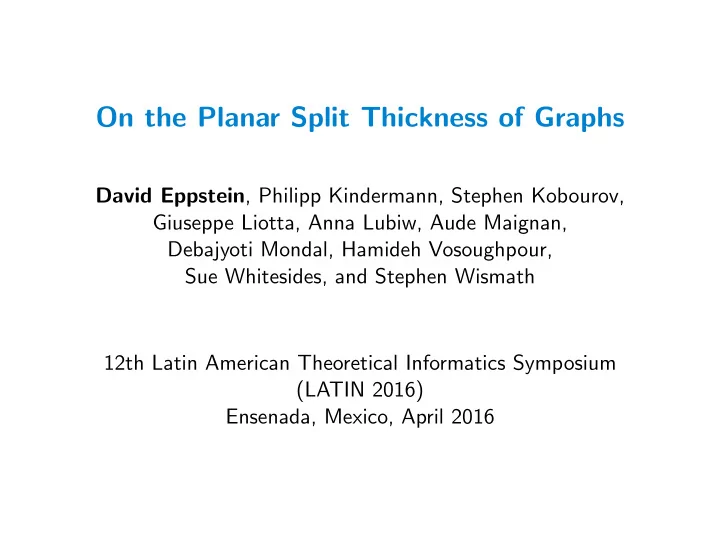

On the Planar Split Thickness of Graphs David Eppstein , Philipp Kindermann, Stephen Kobourov, Giuseppe Liotta, Anna Lubiw, Aude Maignan, Debajyoti Mondal, Hamideh Vosoughpour, Sue Whitesides, and Stephen Wismath 12th Latin American Theoretical Informatics Symposium (LATIN 2016) Ensenada, Mexico, April 2016
Definition by example, I 4 Draw a graph b f e (here, K 7 , 8 ) with: 1 7 0 6 ◮ Each vertex ⇒ e d 2 O(1) points (here, 7 g 3 a 1 g 5 2 points/vertex) ◮ Each edge ⇒ 0 b c 4 2 curve between 5 3 representatives of c f d its endpoints ◮ No crossings 6 a
Definition by example, II d 7 2 Split thickness: a max points/vertex 6 3 (here, 2) b f 1 9 8 c e 2 7 G is k -splittable: 0 it has a drawing with 3 6 a 5 4 e c split thickness ≤ k 4 5 b 1 8 f E.g. this drawing d shows that K 6 , 10 is 2-splittable 9 0
Motivation: Maps of clustered social networks Network itself drawn conventionally (no split vertices) Clusters drawn as regions with ≤ k connected components To construct drawing, need to show cluster graph is k -splittable
Related research Rephrased into our terminology: Heawood 1890: K 12 is 2-splittable Ringel and Jackson 1984: Optimal k -splittability for K n ( n > 6) is k = ⌈ n / 6 ⌉ Hartsfield et al 1985 and later researchers: Split to planar minimizing total # splits rather than splits/vertex Knauer and Ueckerdt 2012: Split vertices to transform graph into several types of trees
Complete bipartite graphs Theorem: K a , b is 2-splittable if and only if ab ≤ 4( a + b ) − 4 8 c 10 d 4 14 15 b 15 12 2 3 5 0 1 9 7 e 4 a 6 c 5 9 11 11 3 2 7 1 0 14 13 d 6 b 8 e 10 13 12 a Proof: ab ≤ 4( a + b ) − 4 ⇒ G ⊂ K 4 , b , K 5 , 16 (above), K 6 , 10 , or K 7 , 8 ab > 4( a + b ) − 4 ⇒ too many edges for bipartite planar drawing
Splittability by maximum degree Let max degree = ∆( G ) Then every graph G is ⌈ ∆( G ) / 2 ⌉ -splittable Regular graphs with odd ∆, high girth are not ⌊ ∆ / 2 ⌋ -splittable: high-girth planar graphs have edges/vertices ≤ 1 + o (1) 1 but any ⌊ ∆ / 2 ⌋ -split would have edges/vertices = 1 + ∆ − 1 .
Splittability by genus Theorem: Toroidal and projective-planar graphs are 2-splittable
Computational complexity Theorem: 2-splittability is NP-complete c 3 c 1 c 2 c' 1 c' 2 c' 3 v 4 v 1 v 2 v 3 v 1 v 2 v 3 v 4 Reduction from planar 3-SAT with a cycle through clause vertices (shown NPC by Kratochv´ ıl, Lubiw, & Neˇ setˇ ril 1991)
Approximation Part of a family of graph parameters (arboricity, thickness, degeneracy, etc) all within constant factors of each other Arboricity a ( G ): minimum # trees whose union is the given graph Every graph is a ( G )-splittable: draw the trees disjointly Every n -vertex k -splittable graph has ≤ (3 k + 1)( n − 1) edges ⇒ (Nash-Williams 1964) a ( G ) ≤ 3 k + 1 So arboricity is a (3 + 1 k )-approximation to splittability (can improve to 3-approximation using pseudoarboricity)
Fixed-parameter tractability Theorem: can test k -splittability of graphs of treewidth ≤ w in time O ( f ( k , w ) · n ) Main ideas: ◮ Use monadic second-order logic (MSO) to represent graph properties as quantified formulae over vertex and edge sets ∀ S ⊂ E ( G ) : ∃ T ⊂ G ( V ) : . . . ◮ A standard DFS-tree trick distinguishes endpoints of each edge ◮ Use edge-set variables to partition the edges according to the vertex-copies that each endpoint connects to ◮ Simulate any MSO formula on the split graph by a more complex formula on the original graph ◮ Planarity = absence of K 5 and K 3 , 3 minors ◮ Use Courcelle’s theorem to construct an automaton that tests whether tree-decompositions obey the formula
Conclusions Defined a new concept of k -splittability, used it to draw nonplanar graphs in a planar way Tight bounds for complete graphs, complete bipartite graphs, and graphs of bounded maximum degree NP-complete but O (1)-approximable, FPT for bounded treewidth Future work: splitting vertices to produce near-planar graphs (e.g. low genus or bounded local crossing number)
Recommend
More recommend